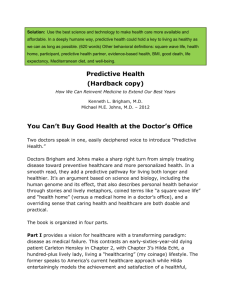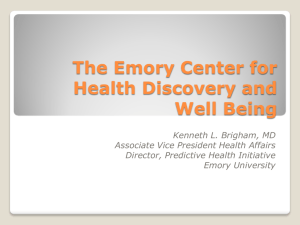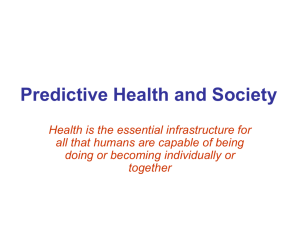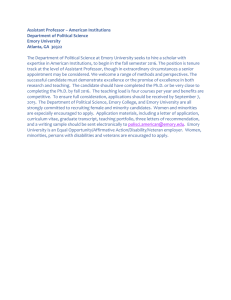Predictive Health
advertisement
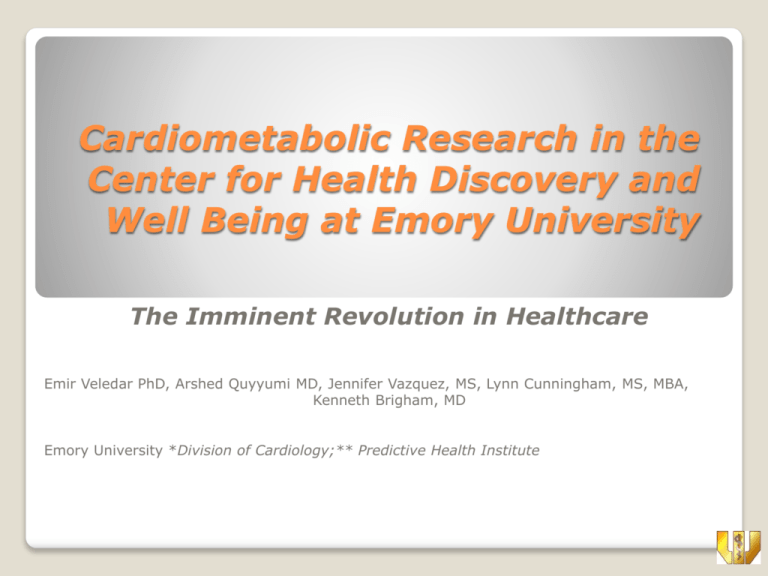
Cardiometabolic Research in the Center for Health Discovery and Well Being at Emory University The Imminent Revolution in Healthcare Emir Veledar PhD, Arshed Quyyumi MD, Jennifer Vazquez, MS, Lynn Cunningham, MS, MBA, Kenneth Brigham, MD Emory University *Division of Cardiology;** Predictive Health Institute Predictive Health the concept The majority of resources in both biomedical research and clinical care is spent on organ and disease focused activities even though end organ failure is often an irreversible process. A third of the Medicare budget is spent in the last year of life and a third of that amount is spent in the last month of life. Research with this focus results in dramatic but increasingly expensive interventions that often have problematic effects on quality of life. Goal for Health system to maintain health rather than to treat disease. implementing general interventions that epidemiological evidence indicates will improve health—“preventive medicine”---in health care systems. New programs of this sort with novel titles are appearing at major academic institutions. shifting emphasis away from end organ failure and toward health maintenance in the health care continuum. That shift will gather momentum if improved efficiency and cost/benefit become more apparent. The shift in focus of biomedical research for biomedical research has been slower to develop. There is a need to focus the formidable power of the research enterprise basic, translational and clinical on developing a positive definition of health in quantitative terms and on developing an evidence base for novel health care paradigms that promise improved cost effectiveness. The shift from disease to health This would provide essential tools for health surveillance, risk assessment and premorbid diagnosis as well as the knowledge base for interventions in essentially healthy people that would preclude progression to end organ failure. Predictive Health Definition “Predictive Health anticipates the course of an individual’s health status, based on leading edge science and technology, and prescribes interventions that proactively optimize wellness” “This revolutionary approach will move from a reactive disease focused system to a pro active health focused system; disease becomes a medical failure” The Health/Disease Continuum Normal Low risk H E A L T H Normal High risk Pre disease Early disease Late disease Predictive Health Contemporary Medicine D I S E A S E Predictive Health and Public Health Congruence Protecting health: The territory DIABETES S ED A IR E IM P COS CE U GL ERAN L TO IR O NM EN T Determinants of Health INFLAM MATION OX IDA ST R T IVE ESS EN V BE HA VIO R T IC NE GE E IV AT L R A I N E NT GE T E E O R P IMMUNE HEALTH EARL Y IT IV E C OGN N NCT IO DYSF U INCREASED CAROTID IMT DEPR ES SI ON Generic Processes NEURODEGENERATIVE DISEASE ATHEROSCLEROSIS PSYCHIATRIC DISORDERS ASY MP PRE T O MAT IC - CAN C ER CANCER Pre-disease Disease Role of Academic Health Centers in the Health Care Transition ◦ Multiple disciplines within one organization ◦ Creative mindset Strong research base ◦ Capacity to foster (and direct) collaborative, interdisciplinary research on a large scale ◦ Catalyst for translational research – integrated basic science, healthcare, public health, and other necessary, supporting disciplines ◦ Objectivity about national economic issues ◦ Organized voice in national debate Predictive Health: Systemic Implications Education ◦ General public ◦ Politicians ◦ Health care professionals Economics ◦ Government ◦ Insurers Information technology The Emory-Georgia Tech Predictive Health Institute Predictive Health Institute Themes •Define and measure health •Invent/discover optimal biomarkers of health •Identify optimal interventions to optimize health •Determine how to apply this new knowledge to individuals and populations Determinants of Health Environment Genomics/ Metabolomics/ Proteomics Genetics Population Biology Behavior Molecular Imaging Systems Biology Generic Pathways Bioinformatics Technologies Nanomedicine Quantitative Medicine Ethics Disciplines Immunology and Inflammation Development Oxidative and Stress Senescence Public Policy Finance and Economics Other Generic Regeneration and Repair Pathways Novel Therapeutics Education Specific Diseases Cardiovascular Diseases Chronic Lung Diseases Cancer Diabetes Neurological Diseases The Emory Georgia Tech Center for Health Discovery and Well Being A partnership of discovery ◦ Discovering individual health ◦ Expanding knowledge of human health in general A new health care paradigm ◦ Health focused ◦ Merging health care and research A grand experiment ◦ Inventing a new health care model Emory-Georgia Tech Center for Health Discovery and Well Being Assessment: The Surveys Surveys collect information about Mental, Emotional & Spiritual health Health Symptoms, Exposure, Behavior & Physical Activity Nutrition, Supplements & Medications Stress, Anxiety, Depression & Sleep Patterns Copyright 2005-2008 Emory University Assessment: Instrumentation Resting Blood Pressure and Heart Rate Anthropometrics & Body Composition % body fat Lean Body Mass Bone Mineral Density Copyright 2005-2008 Emory University Treadmill Fit Testing Vascular Testing Arterial thickness Arterial elasticity Central Blood Pressure Assessment Laboratory Studies More than 50 different lab tests Known biomarkers Endocrine Health Immune Health Metabolic Health Inflammation Health Nutrition Status Copyright 2005-2008 Emory University Research biomarkers Oxidation Status Inflammation Status Immune Function Regenerative Capacity Health Assessment Report Compilation of results from assessments Includes instructions about how to interpret Includes comparison norms (age, gender, etc.) Includes general health education and resources Take home tool Copyright 2005-2008 Emory University Health Action Planning Collaboration with their Predictive Health Partner Participant empowerment & engagement in goal setting What does this mean for the participant Work-life balance Nutrition Physical activity Mental and emotional health Spiritual health Health risk behaviors Personalized Health Action Plan (internal/external resources) Follow up assessments Role of Predictive Health Partner Relationship Builder Facilitator Consultant Educator Translator Confidant Specialist Collaborator Navigator Predictive Health Research The Cardiometabolic Study Cardiometabolic Risk Factors and the Metabolic Syndrome dyslipidemia, insulin resistance, elevated blood pressure and obesity/overweight commonly referred to as the metabolic syndrome. tend to cluster and clearly confer increased risk for the development of atherosclerosis and consequent cardiovascular pathology Coincident with the “epidemic” of overweight/obesity in the United States portending an increase in cardiovascular morbidity and mortality in the future. The syndrome is characterized by increased biomarkers of inflammation and oxidative stress even prior to development of cardiovascular morbidity (Kaya 2009, Dawood 2009). Improved diet and regular exercise have been shown to be effective in reducing various components of the metabolic syndrome (Ma 2009), but public health approaches to effecting such behavior changes have not prevented its increasing incidence Predictive Health The Imminent Revolution in Health Care Study Population A random sample of Emory’s 20,000 employees. Upwards of 300 participants completed an initial evaluation and have been assigned a Health Partner. follow up evaluations at 6 months and one year following enrollment. Drop out less than 2% Demographics characteristics of this cohort are similar to those of the overall Emory employee population: mean age=49+/-10 SD yrs; race- 71% white, 23% black, 5% other; gender- 65% female, 35% male. Income distribution covers the range of employees from <$50K per annum to >$200K per annum household income. Metabolic syndrome criteria The five criteria (ATPIII) that are generally accepted for diagnosing the metabolic syndrome are: 1) 2) 3) 4) 5) waist circumference >=40 inches in men or >=35 inches in women; serum triglycerides >=150 mg/dL or drug treatment for elevated triglycerides; HDL-C <40mg/dL in men or <50mg/dL in women or drug treatment for reduced HDL-C; systolic blood pressure >= 130 mmHg or diastolic blood pressure >=85mmHg or drug treatment for hypertension; and fasting blood glucose >= 100 mg/dL or drug treatment for elevated blood glucose. Figure 1: Percent of study participants to date by numbers of metabolic syndrome criteria met. Additional cardiometabolic risk But that is only a part of the story. A much larger number of healthy participants in this program are at significant cardiometabolic risk. Figure 2: Frequency distribution (percent of participants to date) of body mass index (BMI) Figure 3: Frequency distribution (percent of study participants to date) of systolic blood pressure (mmHg) Figure 4: Frequency distribution (percent of study participants to date) of serum high density lipoproteins (HDL mg/dL). Figure 5: Frequency distribution (percent of study participants to date) of fasting blood glucose concentrations (mg/dL) Figure 6: Frequency distribution (percent of study participants to date) of serum triglyceride concentrations (mg/dL) Table 1: Effects of a 6mo Center for Health Disase and Well being program on variables related to cardiovascular risk (N=51) Baseline (SD) Change @ 6mo (paired mean and SD) P 88.3(12.9) -2.1(8.1) 0.04 67.4(19.4) 2.71(8.43) 0.01 4.7(6.6) 2.75(8.05) 0.008 168.4(35.7) 22.6(44.5) 0.007 28.88(10.34) 3.01(6.17) 0.0002 52.1(9.4) 3.88(7.8) 0.05 4.6(5.3) -1.38(3.77) 0.0045 3.94(3.1) -1.44(2.87) 0.07 18.0(7.9) -2.6(6.5) 0.07 47.5(14.2) 10.3(13.3) <0.0001 118.2(15.1) -3.6(12.5) 0.02 % body fat 33.8(7.5) -0.49 0.05 Body mass index 34.5(7.7) -0.51(2.0) 0.04 variable Fasting glucose (mg/dl) HDL (mg/dl) CD34 count (cells/ul) Total cysteine Augmentation index Mental quality of life (SF36) Beck depression scale General anxiety (GAD7) Perceived stress (PSS) VO2max Systolic BP (mmHg) Pilot data summary collected a broad range of health related information and established a “health profile” for this group. They are at significant cardiometabolic risk. They are accessible, recruitable and retention in the study is high. Initial analysis show significant improvements in cardiometabolic variables As well as other more general measures of health. To further define the nature and extent of cardiometabolic risk in this group of essentially healthy people Primary outcome variables for this study will be appropriate directional improvement in: Waist circumference Serum triglyceride concentration Serum high density lipoprotein (HDL-C) concentration Systolic or diastolic blood pressure Fasting blood glucose concentration Measurements of fundamental processes Markers of oxidative stress Markers of inflammation Progenitor cell populations Immune markers Measurements of cardiovascular structure/function Pulsatile arterial tonometry Arterial Stiffness/Compliance Additional measures of cardiovascular structure/function: Ultrasound-derived carotid artery intimalmedial thickness VO2max (symptom-limited treadmill exercise test) heart rate variability. Partner backgrounds: Minimum of a bachelor’s degree in a health science or related field. A broad range of backgrounds and skills are required to address the integrated complex issues of health definition and maintenance including a basic understanding of human biology. Some background in human behavior is also desirable. Training by the professional staff of the Center will cover the following areas: Predictive Health history, rationale and goals IRB and informed consent process CPR, AED training Customer relations Use of instruments and equipment in the Center Use and purpose of survey instruments Basic physiology, normal and abnormal test and survey results Empathetic and active listening Motivational interviewing Assessing readiness to change Collaborative goal setting Collaborative decision making Goal directed problem solving Elements of coaching, mentoring, supportive engagement The intervention Center process Health assessment and plan Nutrition Physical activity Stress reduction Personalization of the plan Other Partner activities Ongoing contact
